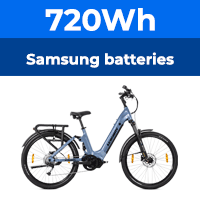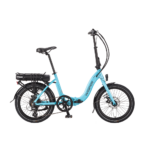Briefing for ETRA meeting
Briefing for the meeting on European electric bike regulations Brussels – 29 September 2009
1. Current situation
All EU member states had to implement Directive 2002/24/EC concerning the type-approval of two or three-wheel motor vehicles.
Pedal assisted bicycles with
Motor automatically cuts out at 25 km/h
Motor output up to 250 W
are excluded from Directive 2002/24/EC, therefore are not subject to moped and motorcycle type-approval bicycles, therefore member states have the right to impose specific requirements, as UK has done subject to EN 15194
Pedal assisted bicycles with
Motor assists beyond 25 km/h
Motor output exceeds 250 W
Bicycles that can be propelled by the motor itself are included in the Directive 2002/24/EC, therefore are subject to moped and motorcycle type-approval mopeds, therefore member states have to right to impose specific requirements with reference to helmets, age limits, number plates, insurance, etc
The Commission is currently reviewing Directive 2002/24/EC. This creates an opportunity to start discussions with the Commission on 2 issues:
1) the 250 W and 25 km/h limit for pedal assisted bicycles to be excluded from the type-approval
2) developing a type-approval procedure which is appropriate for electric bicycles
2. Report on the contact with the European Commission and clarification on the framework of the review
The Commission is currently making an impact assessment of the review of the type-approval. This is a crucial stage for obtaining a change in legislation for electric bicycles. The Commission needs to include that change in the impact assessment. For that purpose, they require three things:
1) a categorisation of electric bicycles
2) a list of technical aspects of the bicycles that need to be type-approved to ensure safety
3) the testing procedures for the type-approval of the listed technical aspects.
We still have some time to develop above-mentioned point 2 and 3. However, for point 1, the Commission requires a proposal before the end of this month! Therefore, the meetings in Las Vegas and in Brussels should result in:
1) definition of the criteria for the exclusion of electric bicycles (now 250 W, 25 km/h)
2) categorisation of electric bicycles not excluded from the type approval.
3. Discussion on the specifications for excluding electric bikes from the type-approval
The exact wording of the current exclusion of pedal assisted bicycles from the type-approval is as follows:
“cycles with pedal assistance which are equipped with an auxiliary electric motor having a maximum continuous rated power of 0.25 kilowatts, of which the output is progressively reduced and finally cut off as the vehicle reaches a speed of 25 km/h, or sooner, if the cyclist stops pedalling.”
I have asked our contact at the Commission what would be a realistic proposition to him, but he answered that he has no idea. In any case, our proposition would have to ensure that the excluded electric bicycles are safe. As a by the by, there is another European Directive which states that only safe products can be put on the market. Furthermore, one has to keep in mind that a change of the specifications for exclusion will entail a change of EN 15194, which has been developed for pedal assisted bicycles up to 250 W and 25 km/h.
Perhaps, the American specifications could be kept in mind. The fact that these guarantee safety in a way that is satisfying American authorities should be a quite convincing element for the European authorities. Furthermore, it would allow us to argue that if the same specifications apply in Europe and in the States, the industry will benefit from the resulting economies of scale
Conclusion: the meeting should result in a proposal for the exclusion of pedal assisted bicycles based on a sound and solid argumentation
4. Discussion on how to develop a type-approval specially designed for not excluded electric bikes
As explained above, this requires three elements:
1) a categorisation of electric bicycles not excluded from the type-approval
2) a list of technical aspects of the bicycles that need to be type-approved to ensure safety
3) the testing procedures for the type-approval of the listed technical aspects
The meeting should result in a proposal for the categorisation of electric bicycles not excluded from the type-approval. We have to submit a proposal to the European Commission before the end of September.
Today, Directive 2002/24 contains definitions of the different categories of mopeds and motorcycles.
The category to which pedal assisted bicycles above 250 W and 25 km/h belong is “Mopeds”, defined as:
Two-wheel vehicles (category L1e) or three-wheel vehicles (category L2e) with a maximum design speed of not more than 45 km/h and characterized by:
(i) in the case of the two-wheel type, an engine whose:
. cylinder capacity does not exceed 50 cm3 in the case of the internal combustion type, or
. maximum continuous rated power is no more than 4 kW in the case of an electric motor;
(ii) in the case of the three-wheel type, an engine whose:
. cylinder capacity does not exceed 50 cm3 if of the spark (positive) ignition type, or
. maximum net power output does not exceed 4 kW in the case of other internal combustion engines, or
. maximum continuous rated power does not exceed 4 kW in the case of an electric motor;
Our contact at the Commission has stated that he is prepared to propose a subdivision of category L1, which could be as follows:
L1 – A: bicycles with an electric motor ….. (to be further defined by the industry)
L1 – B: mopeds with an electric motor … (to be further defined by the industry)
L1 – C: mopeds with an internal combustion engine
With that, the following needs to be kept in mind. The current European type-approval procedure contains specific requirements for 47 components and characteristics to which the conformity of new vehicles must be checked. Electric bikes are exempted of 12 of these requirements, but must conform with the remaining 35 requirements.
For 9 items, the law stipulates that specific requirements will be laid down for low-performance mopeds, i.e. mopeds with pedals, with an auxiliary engine of power not exceeding 1 kW and a maximum design speed not exceeding 25 km/h. So far, the Commission has failed to determine these specific requirements. The requirement list is in an annex to this document.
As said, for now we only require the categorisation. The proposal will be subject to the co-decision procedure, which means that both the European Council (of national ministers) and Parliament will take a final decision on the proposal. That is good because that gives us additional opportunities to lobby for what the industry wants.
However, the industry should take into account that the work does not end here. After our proposal for categorisation, we still need to list the technical elements of the bicycles that will need to be type-approved to ensure safety and specify the testing procedures for the type-approval of the listed technical aspects.








